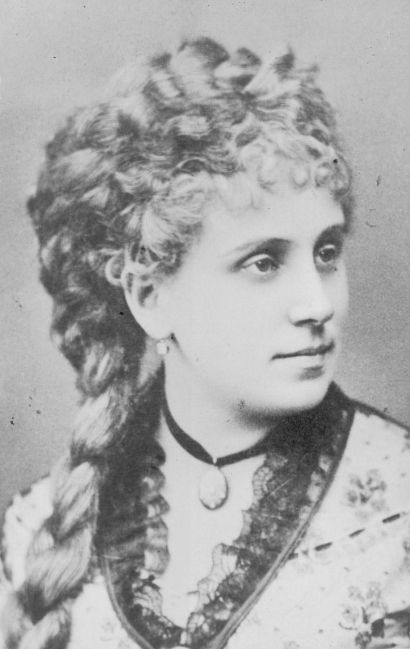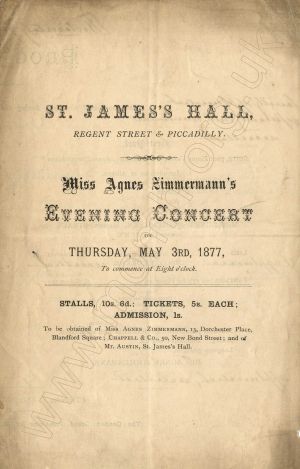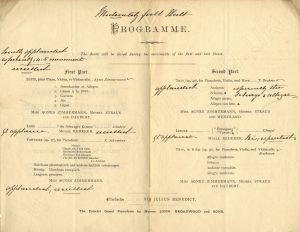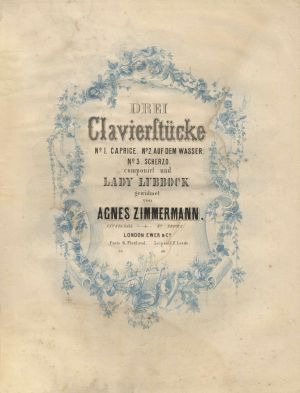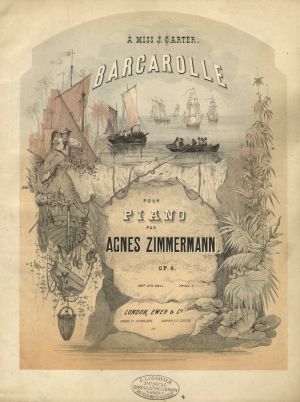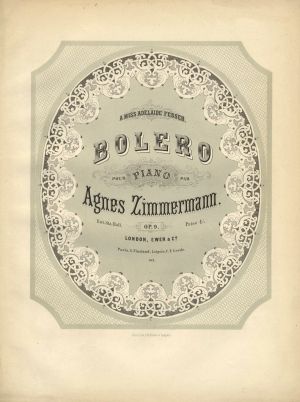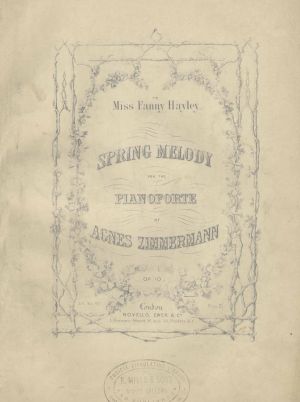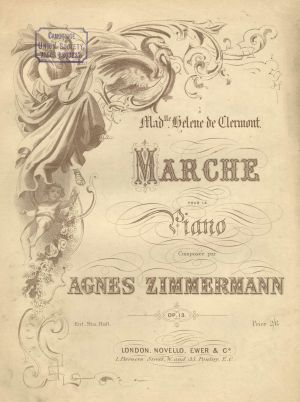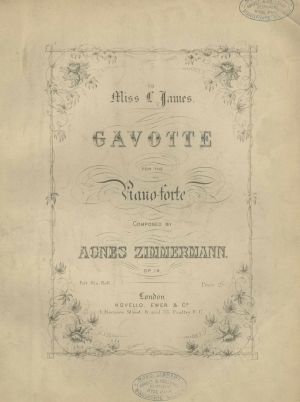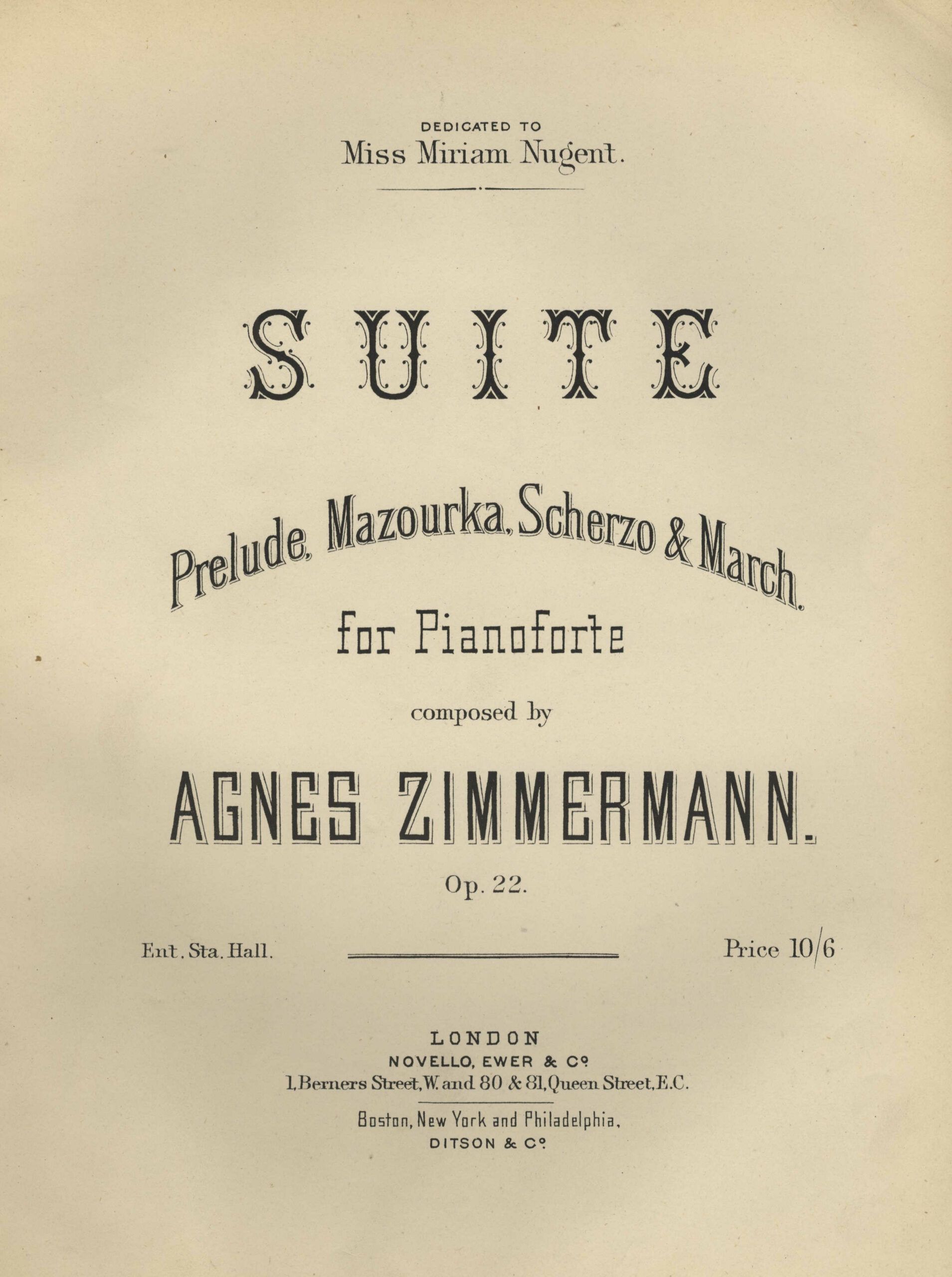Exhibition
Featured Links
Agnes ZIMMERMANN (1847-1925)
October 2023
Zimmermann, (Maria Jacobina) Agnes (b. Cologne, Germany, 5 July 1847; d. London, 14 November 1925)
Agnes Zimmermann achieved renown during the late Victorian era as an accomplished pianist, talented composer and skilled music editor. Although she had settled in London as a child when her parents emigrated from Germany to the British capital in the early 1850s, critic and music historian J.A. Fuller-Maitland counted her among the important native pianists of the late nineteenth century. Others included in that category were Fanny Davies, Leonard Borwick, Frederic Lamond and Adela Verne.
Recognizing the musical talent of their daughter, her parents enrolled Zimmermann at the Royal Academy of Music (RAM) where from 1857 to 1864 she studied piano with Cipriani Potter and Ernst Pauer as well as composition with Charles Steggall and George Macfarren. She twice achieved distinction there as a King’s Scholar (1860–62). While Zimmermann’s close connections with London musicians at the RAM eased her entry into the city’s concert life, she expanded her musical contacts and reputation as a soloist with regular visits to Germany. Following her debut, age 16, at the Crystal Palace with the second and third movements of Beethoven’s Concerto No. 5, Zimmermann continued to build her reputation as a ‘classical’ pianist, one who avoided flashy displays of technical prowess. Her repertoire favored music chiefly by Beethoven, Mendelssohn, Robert Schumann and Brahms but she also played piano solos by Schubert, Chopin, Grieg and Anton Rubinstein and reached into previous eras with compositions by Domenico Scarlatti, J.S. Bach and Mozart. Yet she did not completely eschew works by more flamboyant composers; on occasion she performed a Liszt transcription of a Schubert song or a caprice by Nicolò Paganini.
Violinist Joseph Joachim, a frequent performer in London, bestowed high praise on Zimmermann that helped to advance her career particularly as a performer of chamber repertoire. He endorsed her as ‘a first-rate pianist, indeed, an artist’. Both musicians were frequent soloists at the Monday and Saturday Popular Concert series. Notably, Zimmermann became the first woman to play her own composition at the Popular Concerts when in 1880 she partnered with Joachim and cellist Alfredo Piatti in her Suite in D major, op. 19. Other leading musicians who collaborated with her include violinists Wilhelmine Norman-Nerda (Lady Hallé), Ludwig Straus and cellist Alfredo Piatti. When Zimmermann appeared at orchestral concerts she was likely to be heard playing a concerto by Robert Schumann, Rubinstein, J.S. Bach or Mozart. Like other virtuosos, she toured Britain appearing at the Hallé concerts in Manchester, the Hereford and Norwich Festivals, at events in Edinburgh and Glasgow and in English provincial towns. One of her touring cohorts was the all-female Shinner Quartet.
The MoMH has in its collection a programme for a Zimmermann concert that typifies her approach to concertizing.
Advertisement for Agnes Zimmermann’s concert at St James’s Hall, 3 May 1877. The Musical World, 28 April 1877.
The event took place at St. James’s Hall, a popular London concert venue (1858–1905) that served as the home for the Monday and Saturday Popular Concerts and the Philharmonic Society. Zimmermann had a further connection with the Hall as one of its many shareholders.
Programme for Agnes Zimmermann’s Evening Concert, St James’s Hall, 3 May 1877.
The programme exemplifies her preference for ‘classical’ repertoire and displays a typical structure for a chamber concert of the day: three collaborative works, one solo piece delivered by the concert’s beneficiary and two vocal performances offered as interludes, one in each part of the programme. The First Part features Zimmermann as both composer and performer. Her Suite for Piano, Violin and Violoncello, op. 19, the work she would perform in 1880 with Joachim and Piatti, contains a five-movement structure with titles reminiscent of a Baroque suite: Introduction and Allegro energico, Canon à 7ième, Gavotte, Air allegretto, and Gigue. Yet there would be no mistaking the harmonies and melodies for anything but a Romantic sensibility. The composers and performers were chiefly German by background or training. The latter included violinist Ludwig Straus, cellist Hugo Daubert, horn player Fritz Wendland and contralto Louise Redeker who delivered lieder by Schubert and Paul Klenge. Julius Benedict, a German immigrant, would have accompanied the vocal pieces. (The piano was an English Broadwood.) Zimmermann chose the extraordinarily difficult op. 17 by Schumann to display her abilities as a soloist. Identifying the composer as ‘R. Schumann’ distinguished him from Clara Schumann whose regular visits to England would have made her well known among concertgoers at that time. The Second Part opens with a Trio for piano, cello and natural (not valved) horn by Brahms offering a varied instrumental sonority. After two lieder by Klengel, the programme concluded with the popular Archduke Trio by Beethoven. Handwritten comments on this programme by an anonymous listener invite readers nearly 150 years later to imagine themselves as members of that audience. We learn that each piece received hearty applause, in particular the Air and Gigue in Zimmermann’s Suite, her rendering of the Schumann Fantasie and the Brahms Scherzo and Allegro.
Zimmermann, the composer, favoured chamber works and piano solos, in addition to some vocal music and piano arrangements of music by Haydn, J.S. Bach, Handel, Beethoven and Schubert. MoMH’s collection includes a number of her piano solos the title pages of which are illustrated below.
1. Drei Clavierstücke No.1 Caprice. No.2 Auf dem Wasser. No.3. Scherzo. London, [1865?]. 2. Barcarolle, Op.8. London, [1868]. 3. Bolero, Op.9. London, [1868].
1. Spring Melody, Op.10. London, [1869]. 2. Marche, Op.13. London, [1869]. 3. Gavotte, Op.14, [1870?].
Suite for Piano Prelude, Mazourka, Scherzo & March, Op.22. London, [1878].
But her finest chamber works are considered to be her three Violin Sonatas, opp. 16, 21, 22. Violinists Joachim and Wilhelmine Norman-Neruda (Lady Hallé) regularly played them with her at London concerts.
Unusual for her time, Zimmermann published her own music editions. These included sonatas by Mozart and Beethoven and the piano works of Robert Schumann. In her preface to the first volume of Schumann’s complete works for piano, she acknowledged that translating the German terms and directions had been a difficult task despite her German background. In addition, she observed that a ‘source of great inconvenience to students and players’ was the lack of uniformity in signs to indicate fingering. A system currently in Britain employed ‘+’ to designate the thumb, with 1, 2, 3, 4 denoting the remaining fingers. Zimmermann adopted the Continental system (1, 2, 3, 4, 5) making her Novello publications some of the first in Britain to do so.
The year following Zimmermann’s May 3rd 1877 concert, she moved in with Dame Louisa Sophia Goldsmid following the death of her husband Sir Francis Goldsmid. This arrangement lasted thirty years until the death of Louisa in 1908. The MoMH owns a copy of Lady Goldsmid’s will that named Zimmermann one of its three executors. She bequeathed the pianist an annuity along with the use of Goldsmid’s house in Tunbridge Wells and an option of residing at Goldsmid’s London house at 13 Portman Square. These generous bequests left Zimmermann financially secure. This would be especially important as references describe an unnamed ‘serious illness’ and diminishing eyesight that resulted in Zimmermann reducing her public appearances, particularly after the 1890s. Her final public performance occurred in 1913, but Zimmermann continued to play privately, relying on her excellent memory, and hosted regular Wednesday musical gatherings and an annual musical party. Due to her range of skills as a performer, composer and collaboration with some of most important musicians of the day, Agnes Zimmermann remains an important figure in the history of Victorian pianism.
SOURCES
Arbuthnot, Lady Constance. ‘In Memoriam: Agnes Zimmermann: Pianist and Composer, 1847–1925’ in The Musical Times, 1 January 1926, vol. 67: 28–29.
Fuller, Sophie. The Pandora Guide to Women Composers: Britain and the United States 1629–Present (Pandora, 1994).
Kennedy, Joan. Chapter 8 ‘Daughter Churches’ in Our Lady of Ransom, in Gratitude and Hope (Oxford University Press, 2001).
Letters from and to Joseph Joachim. Selected and translated by Nora Bicklye. Preface by J.A. Fuller-Maitland (London: Macmillan, 1914).
Scholes, Percy A. The Mirror of Music, 1844–1944: A Century of Musical Life in Britain, 2 vols. (Novello and Oxford University Press, 1947).
Schumann, Robert. Complete Works for the Pianoforte, vol. 1, Preface. Edited and Fingered by Agnes Zimmermann (London & New York: Novell, Ewer & Co.).
Sophie Drinker Institut. https://www.sophie-drinker-institut.de/zimmermann-agnes.
The Times, 17 November 1925: 16.
Online performances of works by Agnes Zimmermann referenced in this entry:
Suite for Piano, Violin and Violoncello, op. 19.
Violin Sonatas No. 1, op. 16; No. 2, op. 21; No. 3, op. 23.
Therese Ellsworth, 2023.
